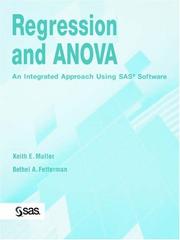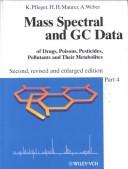| Listing 1 - 4 of 4 |
Sort by
|
Book
ISBN: 9781849208765 Year: 2005 Publisher: London : SAGE,
Abstract | Keywords | Export | Availability | Bookmark
 Loading...
Loading...Choose an application
- Reference Manager
- EndNote
- RefWorks (Direct export to RefWorks)
Demonstrating how the methods and findings of conversation and discourse analysis may inform the development of empirical research questions, this text offers clear comparisons between the two approaches, as well as offering a positioned argument.

ISBN: 0471469432 9780471469438 Year: 2003 Publisher: Hoboken, N.J.: Wiley,
Abstract | Keywords | Export | Availability | Bookmark
 Loading...
Loading...Choose an application
- Reference Manager
- EndNote
- RefWorks (Direct export to RefWorks)
Regression analysis --- Anaylsis of variance --- Data processing --- SAS (Computer file) --- 519.2 --- -Regression analysis --- -681.3*G --- Analysis, Regression --- Linear regression --- Regression modeling --- Multivariate analysis --- Structural equation modeling --- Probability. Mathematical statistics --- Mathematics of computing --- Analysis of variance --- Data processing. --- 681.3*G Mathematics of computing --- 519.2 Probability. Mathematical statistics --- 681.3*G --- ANOVA (Analysis of variance) --- Variance analysis --- Mathematical statistics --- Experimental design --- Statistical analysis system --- SAS system --- Regression analysis - Data processing --- Anaylsis of variance - Data processing

ISBN: 3527269894 0895738554 3527288805 3527297936 Year: 1992 Publisher: Weinheim VCH
Abstract | Keywords | Export | Availability | Bookmark
 Loading...
Loading...Choose an application
- Reference Manager
- EndNote
- RefWorks (Direct export to RefWorks)
Announcing a new volume of Pfleger/Maurer/Weber: Mass Spectral and GC Data of Drugs, Poisons, Pesticides, Pollutants and Their Metabolites. Unmatched in scope, quality and reliability, this collection is the result of a unique effort.Part 4 of this famous reference work contains- 2000 new mass spectra (more than 6300 in Part 1-4)- data of nearly all the new drugs relevant to clinical and forensic toxicology, doping control, food chemistry, etc.- nearly complete coverage of trimethylsilylated, perfluoroacylated, perfluoroalkylated and methylated compounds- data revision of already published volumes in this second edition- updated sections on sample preparation and GC-MS methods- tables covering all the data of Parts 1-4 with directions as to page and volume on/in which the data can be found as well as the appropriate entry numbers of the electronic versions (tables listed by names and categories).The complete set of Part 1-4 now comprises more than 6300 mass spectra and reaches far beyond the needs of clinical and forensic toxicologists. The inclusion of pesticides and pollutants makes this data collection invaluable for environmental chemists, occupational toxicologists and food analysts, too.The data of the supplement volume will also be provided as an up-grade of the computer libraries (PMW_TOX3) by producers of mass spectrometers, e.g., Hewlett Packard, Finnigan (MAT, CE, Automass), Shimadzu and Varian.
Analysis of pharmaceuticals --- Toxicology --- Drugs --- Gas chromatography --- Mass spectrometry --- Poisons --- Chromatography, Gas --- Spectrum Analysis, Mass --- Analysis --- Tables --- handbooks --- analysis --- -Poisons --- -Mass spectrometry --- -Gas chromatography --- -Gas-liquid chromatography --- GLC (Chromatographic analysis) --- Vapor-phase chromatography --- Chromatographic analysis --- Mass spectra --- Mass spectrograph --- Mass spectroscopy --- Mass spectrum analysis --- Mass (Physics) --- Nuclear spectroscopy --- Spectrum analysis --- Chemicals --- Poisonous chemicals --- Poisonous substances --- Toxic chemicals --- Toxic substances --- Toxicants --- Toxics --- Bioactive compounds --- Hazardous substances --- Medicaments --- Medications --- Medicine (Drugs) --- Medicines (Drugs) --- Pharmaceuticals --- Prescription drugs --- Medical supplies --- Pharmacopoeias --- Chemotherapy --- Materia medica --- Pharmacology --- Pharmacy --- -Tables --- Tables. --- handbooks. --- anaylsis --- -Analysis --- Pharmaceutical Preparations --- Mass Spectrometry --- Handbooks. --- Anaylsis
Book
ISBN: 0367897245 1317133544 1317133536 1315582937 1472482581 Year: 2018 Publisher: Taylor & Francis
Abstract | Keywords | Export | Availability | Bookmark
 Loading...
Loading...Choose an application
- Reference Manager
- EndNote
- RefWorks (Direct export to RefWorks)
This book is about Erving Goffman’s frame analysis as it, on the one hand, was presented in his 1974 book Frame Analysis and, on the other, was actually conducted in a number of preceding substantial analyses of different aspects of social interaction such as face-work, impression management, fun in games, behavior in public places and stigmatization. There was, in other words, a frame analytic continuity in Goffman’s work. In an article published after his death in 1982, Goffman also maintained that he throughout his career had been studying the same object: the interaction order. In this book, the author states that Goffman also applied an overarching perspective on social interaction: the dynamic relation between ritualization, vulnerability and working consensus. However, there were also cracks in Goffman´s work and one is shown here with reference to the leading question in Frame Analysis – what is it that’s going on here? While framed on a "microsocial" level, that question ties in with "the interaction order" and frame analysis as a method. If, however, it is framed on a societal level, it mirrors metareflective and metasocial manifestations of changes and unrest in the interaction order that, in some ways, herald the emphasis on contingency, uncertainty and risk in later sociology. Through analyses of social media as a possible new interaction order – where frame disputes are frequent – and of interactional power, the applicability of Goffman’s frame analysis is illustrated. As such, this book will appeal to scholars and students of social theory, classical sociology and social interaction.
Social psychology. --- Social interaction. --- Experience. --- Goffman, Erving. --- Knowledge, Theory of --- Philosophy --- Psychology --- Reality --- Pragmatism --- Human interaction --- Interaction, Social --- Symbolic interaction --- Exchange theory (Sociology) --- Social psychology --- Mass psychology --- Psychology, Social --- Human ecology --- Social groups --- Sociology --- Goffman, Erving, --- גופמן, ארווינג --- anaylsis --- book --- chess --- frame --- Goffman --- impression --- management --- online --- order --- sociology --- social interaction --- interaction --- social media --- Goffman, Erving
| Listing 1 - 4 of 4 |
Sort by
|

 Search
Search Feedback
Feedback About UniCat
About UniCat  Help
Help News
News